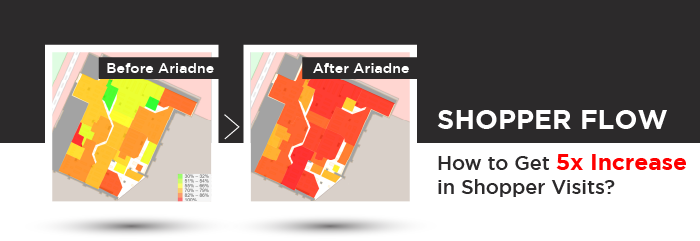Why should we love shopper flow insights?
Retail store layout, or store design, is the layout that retailers use to organize their products, fixtures, and merchandise in brick-and-mortar stores. Traditionally, a primary goal of store layout is to improve shopper flow and maximize sales, leveraging best performing categories adjacencies. The layout designer must consider that people do not navigate the same way in each store. Products (apparel, groceries, furniture, hardware, etc.), demographics, store location, available space, and target customers, all need to be considered when creating specific store layouts.
Outline
- Shopper Flow Insights
- What is happening in reality
- What can the retailer do?
- Positioning matters
- Make it last longer
- Popular and nonpopular: The perfect match
- Ultimate match, a strategic match
- Conclusion
The post-COVID rebirth of the brick-and-mortar retail requires a customer-centric layout that directly corresponds to the new way that shoppers navigate those stores. Store layout design should not just include enhancing shopper navigation. Insights about the shopper flow patterns allow retailers to optimise the design of new layouts that will attract more customers, encourage the impulsive pick up of products and create a memorable shopping experience. Creating the right shopping experience is critical as physical retail still represents most sales and customers expect an experience that can’t be provided online.
Let’s see how a well-known retailer used shopper flow analytics and small changes in the store layout to drive a 5X increase in shopper visits to specific areas and increase sales.
What is happening in reality?
Poor traffic flow is a common issue in retail stores, negatively impacting the customer experience and discouraging shoppers from spending more time exploring the store and purchasing more. Poor category positioning, narrow or twisted aisles, and blocked shoppers’ views are some of the typical mistakes in store layout. Additionally, categories are often placed close to each other based on experience, intuition, and gut feel rather than real data, further confusing shoppers attempting to complete their shopping mission and even upsetting shoppers with overcrowded aisles, departments, and fixtures.
If not addressed, stores will face disorganized traffic flows, cramped product areas, and a horrible customer experience leading to less shopper exploring and decreased sales and loyalty. Ariadne’s Shopper Journeyfeature gives retailers the ability to track shoppers and their journeys, including major and minor shopper flows, optimize in-store traffic patterns, and continued enhancement of store layout. The resulting optimized store design enhances the customer experience, increases cross-selling and up-selling, and boosts loyalty and sales.
What can the retailer do?
A large retailer is using Ariadne’s platform to track thein-store shopping journey and optimize the layout of each store. To achieve that, the retailer started with insights from two stores.The comparison of shopper journeys, including dominant shopper flows, revealed good and bad practices significantly influencing the shopper journey.
1. Positioning matters
As many studies have found, less visited product areas benefit when they are placed on the right side of more visited or popular areas as customers tend to move to the right. In the illustrations below, two different stores positioned a less visited product category - TV sets in this case – in different locations. By using the Ariadne platform, the retailer was able to see the data proving that when the TV department is placed to the right of the IT department products (Store B), the TV department is visited by far more shoppers compared to visitors resulting from the placement in Store A. This small difference in the TV department location is resulting in 5X increase in TV department traffic and a significant increase in sales.
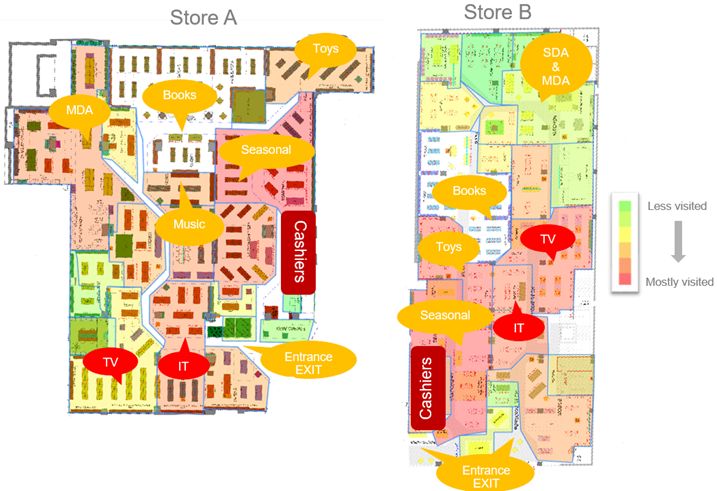
2. Make it last longer
Using Ariadne, this retailer discovered that popular product areas placed at the centre of the store or near the cashiers was interrupting shopper journeys early, resulting in lost sales. Books are one of the top categories for this retailer, so their location in the store has a significant impact to shopper flow. As shown in the illustration below, Store B placed books near the centre of the store. As a result, almost half of the store is rarely visited because customers have already accomplished their intended shopping goal. The placement of books in Store B disrupts the shopper journey, forcing it to end prematurely. However as seen below, Store A placed Books in the back, resulting in a far better customer journey distribution among all departments and across the entire store, impacting both customer experience and sales.
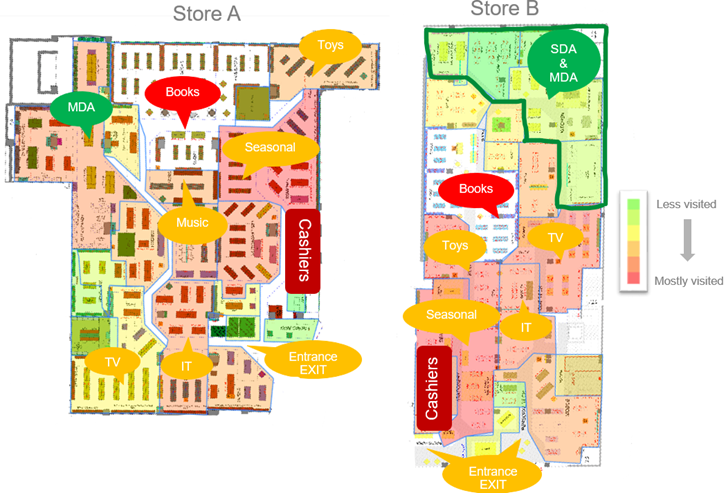
3. Popular and non-popular: The perfect match
This retailer also learned that placing the most visited product categories side by side disrupted shopper navigation, negatively impacting all product categories. Using actual data, they were able to learn, and see, that putting popular categories next to each other resulting in many shoppers gathering in the same areas and discouraging other shoppers from visiting or passing through those areas. Shoppers were discouraged and decreased additional store exploration, decreasing sales. This effect is even more pronounced post-COVID as shoppers avoid crowded and cramped spaces. A real example of this effect is seen in the illustration below. In Store B the IT department is near Books. As both Books and IT are popular departments they draw the most shoppers, creating the crowd effect and discouraging other shoppers from additional exploration and visiting areas beyond those two departments. With this discovery, this retailer was addressed combining popular with less popular product areas. In Store A, the Major Domestic Appliances (MDA), a less visited department, was placed next to Books, a popular category. The retailer was able to measure the result with Ariadne’s platform, with the data showing that shopper flow was spread out, supporting better shopper journeys, more shoppers visiting more departments, increased exploration of less visited areas, and increased to sales.
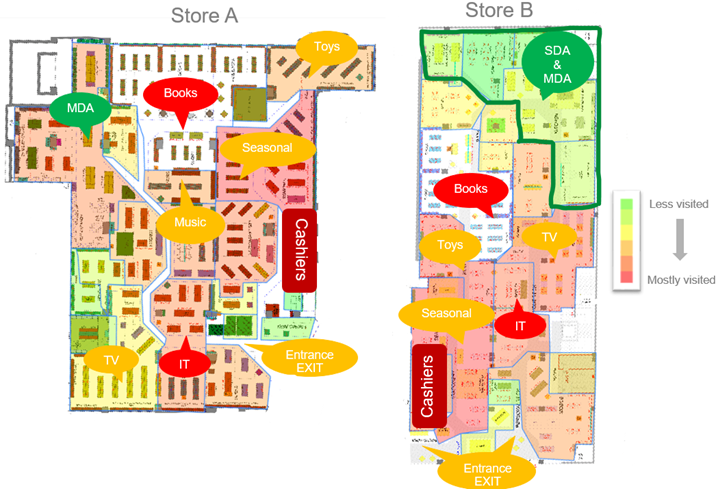
4. Ultimate match, a strategic match
Good store design and layout also enables shoppers to find various products in a more convenient way. By positioning more often visited and less often visited categories that are complementary, the perfect match above is transformed into a strategic match. This design strategy encourages increased store exploration, creates product discovery, and results in increased impulse purchases as well as the cross-selling and up-selling benefits outlined previously. In Store A, shown below, the Toy department was placed in what could be seen as a challenging location. However, because of its positioning adjacent to Children’s Books, shoppers visited Toys even more often and the cross-selling impact from Books was 94%.
With this strategic match approach, Store A was able to free up valuable space within the shopper’s journey by moving Toys and moving MDA adjacent to Books. Although MDA and Books would not seem to be complementary, that move resulted in a 2X increase in visitors to the MDA area and a significant increase to sales as well.
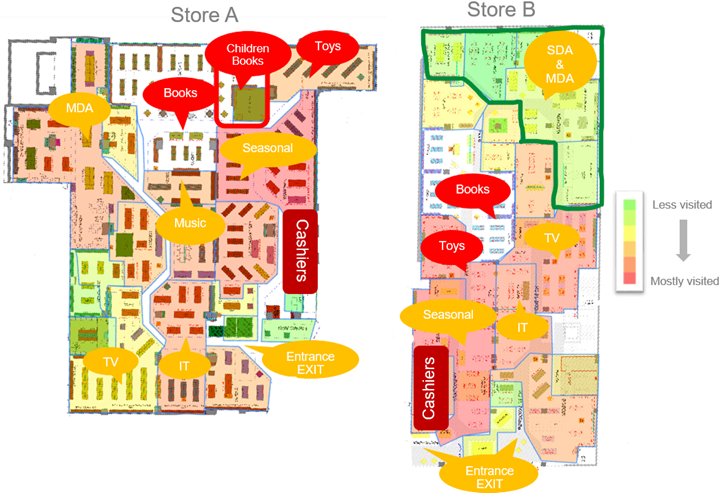
Conclusion
This real and simple case study proves that retail store layout design is not just about improving navigation. It now requires a deep understanding of shopper flow, including critical insights about customer journeys in specific stores including shopper paths, flow patterns, number of customers, areas visited, time in each area, and more. With this data and insights retailers can design and continuously improve store layouts that support shopper exploration, an exceptional customer experience, increased conversion at store and department level, and significantly increased store performance. Retail winners post-COVID-19 will understand their shopper’s journeys through data and insights, allowing them to optimize the customer experience and reap the rewards of increased loyalty and sales.
Want to learn more about how Ariadne supports retailers in tracking shopper flow patterns? Go ahead and book an appointment: Let's Talk!





